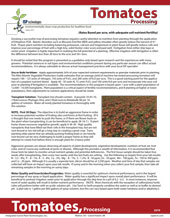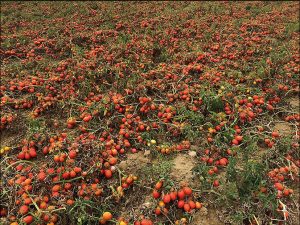
Growing a successful crop of processing tomatoes requires careful attention to nutrition from planting through the application of Ethephon PGR. Abiotic disorders such as Blossom End Rot (BER) and yellow shoulder often greatly reduce the harvest of #1 fruit. Proper plant nutrition including balancing potassium, calcium and magnesium in plant tissue will greatly reduce culls and improve your percentage of fruit with a high brix, solid Hunter color score and peel well. Fertigation from either rip tape or center pivot irrigation is highly important in realizing the full potential of a planting. Effective irrigation with fertigation is often the difference between less than 20 tons to the acre and 50+ tons.
It should be noted that this program is presented as a guideline only based upon research and the experiences with many growers. Potential variances in soil types and environmental conditions present during any particular season can affect actual recommendations. It is always advisable to discuss actual management practices with your local ISP specialist.
Dry or Bulk Fertilizer: Apply approximately 50% of your expected nutrient requirements as granular materials prior to planting. The Mid-Atlantic Vegetable Production Guide estimates that an average yield of machine harvested processing tomatoes will require 100-125 units of nitrogen, 150 units of P205, and 200 units of K2O per acre. This is a good starting point for the application of a preplant nutrient blend. Apply 40-50 units N, 75 units P2O56, and 100 units of K2O per acre and incorporate into your soil prior to planting if fertigation is available. The recommendations in this program is based upon 1 acre with a plant population of 12,000 – 14,500 transplants. Plant population is a critical aspect of fertility recommendations, and if planting at higher or lower populations, then adjustments to nutrient applications should be made.
 Transplant Solution: Transplant mix should contain: .8 pounds 10-45-10, 3 fluid ounces PhytoGro Xtra, and 2 fluid ounces MetaboliK SB per 10 gallons of solution. Water all newly planted tomatoes in thoroughly with this solution.
Transplant Solution: Transplant mix should contain: .8 pounds 10-45-10, 3 fluid ounces PhytoGro Xtra, and 2 fluid ounces MetaboliK SB per 10 gallons of solution. Water all newly planted tomatoes in thoroughly with this solution.
NOTE, First 30 days: The objective is to build an aggressive frame in order to increase potential number of fruiting sites and forms at first fruiting. (If it is thought that one needs to push the frame, or if there are flower buds on the plant when transplanting, it can be beneficial to apply 28-16-7.) If plant frame shows excessive vegetative growth, apply 0-36-30. High quality transplants that have filled out their cells in the transplant tray but are not root bound or too old will go a long way to creating a great crop. Transplanting older plants that are already pushing fruiting buds or are heavily root bound can be very challenging to build a proper frame as they will attempt to create fruit before there is enough plant for a heavy yield.
Aggressive growers are always observing all aspects of plant development, vegetative development, numbers of fruit set, fruit color, and of course any outbreak of pets or disease. Although this provides a wealth of information, it is recommended that tissue tests be taken to monitor actual nutrient uptake and potential deficiencies. The first tissue sample should be taken four weeks after transplanting, then every two weeks until the last fruits are setting. Use the following as targets from your lab results: N – 3.5-4%; P – .8-1%; K – 3-4%; Ca – 3%; Mg – .8-1%; S – 1.2%; B – 50ppm; Zn – 50ppm; Mn – 100ppm; Fe – 100-400ppm; and Cu – 20ppm. Although it is usually a separate test, silicon should be at 3,500ppm. Weather and time of day that samples are collected will have an impact upon your lab results. If sunny and in the morning when you collect your first sample, then take all remaining samples in the morning on sunny days.
Water Quality and Insecticides/Fungicides: Water quality is essential for optimum chemical performance and is the largest percentage of any spray or liquid application. Water quality has a significant impact upon overall plant performance. It will be beneficial to pretreat irrigation water prior to application through the drip lines to a pH of 6.2-6.5. In most instances, improvement of water quality will result in better nutrient performance. (NOTE: Most chemicals with the exception of sulfonylurea herbicides will perform better with an acidic solution pH. Use Torch to both properly condition the water as well as to buffer to desired pH. (Label rate is 1 gallon per 800 gallons of spray solution, but this can vary based upon both water hardness and/or alkalinity.))
The following table is designed for full season, processing tomatoes where fertigation is possible. Prolonged cool, cloudy periods will add days to this schedule, and extreme heat can shorten the schedule.
| ISP Soluble Plant Foods | ||
| Week | Recommended | Other notes, micronutrients, Ca, Mg |
| 1 | 17.5 pounds 10-20-20 & 6.0 pounds 28-16-7 | |
| 2 | 17.5 pounds 10-20-20 & 6.0 pounds 28-16-7 | Observe frame development. |
| 3 | 22 pounds 10-20-20 & 7.5 pounds 28-16-7 | Observe frame & fruit development |
| 4 | 22 pounds 10-20-20 & 10 pounds 28-16-7 | Tissue test 4 weeks following planting, and adjust nutrient accordingly. |
| 5 | 22 pounds 10-20-20 & 20 pounds 9-14-24 | Begin adding 8oz. SiMag58, and 16 fluid ounces CalStore or MetaCal per week |
| 6 | 22 pounds 10-20-20 & 20 pounds 9-14-24 | Include 2tsp. MetaboliK HV-1 every 10-14 days with your disease management program. Time for Second tissue test. |
| 7 | 22 pounds 10-20-20 & 44 pounds 4-18-38 | Continue SiMag58 and MetaCal/CalStore |
| 8 | 22 pounds 10-20-20 & 44 pounds 4-18-38 | Continue SiMag58 & MetaCal/CalStore until end of season. Third tissue test. |
| 9 | 85 pounds 4-18-38 | |
| 10 & 11 | 85 pounds 4-18-38 | Fourth tissue test. |
| 12-end | 85 pounds 4-18-38 | Fifth tissue test if harvest is to be maintained. |
| Continue to repeat weeks 10-12 or until the application of Ethephon | Adjust nutrient based on tissue sample. | |
 Getting the most out of non-irrigated processing tomatoes: Apply 50% of the expected granular/dry nutrients prior to planting. Apply the remaining nutrients at 4 weeks after transplanting as a liquid side dress application with PhytoGro Xtra at 16-24 fluid ounces per acre. If another 30 units of N is required, then split the application between 10-20-20 and 9-14-24(equates to 150 pounds 10-20-2-20 + 170 pounds 9-14-24 per acre) + 16-24 fluid ounces PhytoGro Xtra. Begin applying 2-4 pounds per acre 4-18-38 weekly as a foliar (with crop protection products) from the beginning of fruit set until the application of Ethephon.
Getting the most out of non-irrigated processing tomatoes: Apply 50% of the expected granular/dry nutrients prior to planting. Apply the remaining nutrients at 4 weeks after transplanting as a liquid side dress application with PhytoGro Xtra at 16-24 fluid ounces per acre. If another 30 units of N is required, then split the application between 10-20-20 and 9-14-24(equates to 150 pounds 10-20-2-20 + 170 pounds 9-14-24 per acre) + 16-24 fluid ounces PhytoGro Xtra. Begin applying 2-4 pounds per acre 4-18-38 weekly as a foliar (with crop protection products) from the beginning of fruit set until the application of Ethephon.
Apply MetaCal, or CalStore through the fertigation system weekly when not applying any P containing nutrients. Fill irrigation lines with water, inject CalStore or MetaCal, then flush lines with clear water. This will ensure that no clogging precipitates are formed and that your developing fruit get plenty of calcium in balance with magnesium.
Foliar Application: Foliarly applied nutrient (K, Ca and Mg) will greatly assist growers in maintaining sufficient amounts of these nutrient when coupled with a proper fertigation program, especially at key stress points. Examples are fruit set and/or maintaining vegetative growth with a heavy fruit load. Include ISP Plant food and SiMag58 at 1-2tsp each per gallon of foliar solution. Spray weekly with any pest management foliar applications. Calcium supplements CalStore and MetaCal can be applied foliarly with pest management materials, but not with 4-18-38 in order to avoid any reactions with phosphorous (P).
